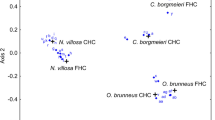Abstract
Male gypsy moths (Lymantria dispar L.) in a wind tunnel at 24° respond to decreasing dosages (1 μg to 0.1 pg) of (+)-cis-7,8-epoxy-2-methyloctadecane with a decrease in probability of wing-fanning, an increase in wing-fanning latency, and an increase in the number of behaviors (body jerks, antennal twitches, steps, and wing tremors) preceding fanning. Males initiating any behavior prior to wing-fanning had a 70% probability of wing-fanning and 97% of the males that wing-fanned eventually flew. The sequence of behaviors from quiescence to flight is not organized in a hierarchy, as this concept is used in ethology, nor is it dependent upon the concentration of pheromone. The time-average threshold concentration of pheromone for response of ca. 90% or more quiescent males is ca. 1.9 × 10−17 g/cm3 over < 0.3 min.
Similar content being viewed by others
References
Baerends, G.P. 1976. The functional organization of behaviour.Anim. Behav. 24:726–738.
Baerends, G.P., Brower, R., andWaterbolk, H.T. 1955. Ethological studies onLebistes reticulatus (Peters)Behaviour 8:249–334.
Bartell, R.J. 1977. Behavioral responses of Lepidoptera to pheromones, pp. 201–213,in H.H. Shorey and J.J. McKelvey, Jr. (eds.). Chemical Control of Insect Behavior. Academic Press, New York.
Bartell, R.J., andShorey, H.H. 1969. Pheromone concentrations required to elicit successive steps in the mating sequence of males of the light-brown apple mothEpiphysas postvittana.Ann. Entomol. Soc. Am. 62:1206–1207.
Cardé, R.T., andHagaman, T.E. 1979. Behavioral responses of the gypsy moth in a wind tunnel to air-borne enantiomers of disparlure.Environ. Entomol. 8:475–484.
Carde, R.T., andHagaman, T.E. 1983. Influence of ambient and thoracic temperatures upon sexual behaviour of the gypsy moth,Lymantria dispar.Physiol. Entomol. 8:7–14.
Cardé, R.T., Doane, C.C., andRoelofs, W.L. 1974. Diel periodicity of male sex pheromone response and female attractiveness in the gypsy moth (Lepidoptera: Lymantriidae).Can. Entomol. 106:479–484.
Charlton, R.E., andCardé, R.T. 1982. Rate and diel periodicity of pheromone emission from female gypsy moths,Lymantria dispar (L.) determined with a glass adsorption collection system.J. Insect Physiol. 28:423–430.
Colgan, P.W., andSlater, P.J.B. 1980. Clustering acts from transition matrices.Anim. Behav. 28:965–966.
Dawkins, R., andDawkins, M. 1976. Hierarchical organization and postural facilitation: Rules for grooming in flies.Anim. Behav. 24:739–755.
Douglas, J.M., andTweed, R.L. 1979. Analyzing the patterning of a sequence of discrete behavioural events.Anim. Behav. 27:1236–1252.
Elkinton, J.S.,Cardé R.T., andMason, C.J. 1984. Evaluation of time-average dispersion models for estimating pheromone concentration in a deciduous forest.J. Chem. Ecol. In press.
Fagen, R.M., andGoldman, R.N. 1977. Behavioural catalogue models.Anim. Behav. 25:261–274.
Farnum, D.G., Veysoglu, T., Carde, A.M., Duhl-Emswiler, B., Pancoast, T.A., Reitz, T.J., andCardé, R.T. 1977. A stereospecific synthesis of (+)-disparlure, sex attractant of the gypsy moth.Tetrahedron Lett. 46:4009–4012.
Halliday, T.R. 1975. An observational and experimental study of sexual behavior in the smooth newt,Triturus vulgaris (Amphibia: Salamandridae).Anim. Behav. 23:291–322.
Rust, M.K. 1976. Quantitative analysis of male responses released by female sex pheromone inPeriplaneta americana.Anim. Behav. 24:681–685.
Schwinck, I. 1958. A study of olfactory stimuli in the orientation of moths.X Int. Cong. Entomol. 2:577–582.
Shorey, H.H. 1973. Behavioral responses to insect pheromones.Annu. Rev. Entomol. 18:349–380.
Slater, P.J.B. 1973. Describing sequences of behavior, pp. 131–154,in P.P.G. Bateson and P.H. Klopfer (eds.). Perspectives in Ethology. Plenum Press, New York.
Tinbergen, N. 1950. The hierarchical organization of nervous mechanisms underlying instinctive behaviour.Symp. Soc. Exp. Biol. 4:305–312.
Author information
Authors and Affiliations
Additional information
Lepidoptera: Lymantriidae.
Michigan Agricultural Experiment Station Journal Article No. 10263.
Rights and permissions
About this article
Cite this article
Hagaman, T.E., Cardé, R.T. Effect of pheromone concentration on organization of preflight behaviors of the male gypsy moth,Lymantria dispar(L.). J Chem Ecol 10, 17–23 (1984). https://doi.org/10.1007/BF00987639
Received:
Revised:
Issue Date:
DOI: https://doi.org/10.1007/BF00987639




